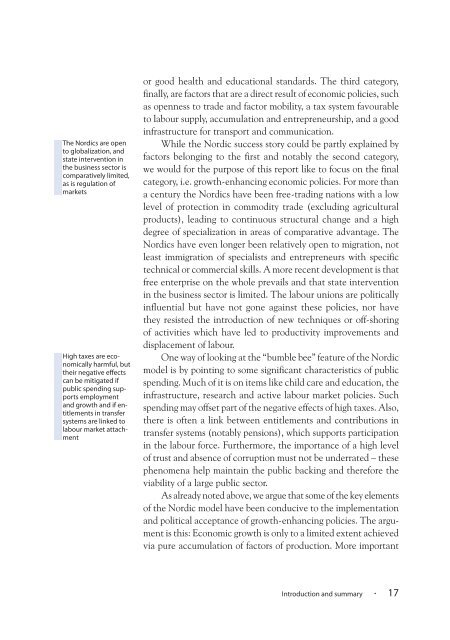The Nordic Model - Embracing globalization and sharing risks
The Nordic Model - Embracing globalization and sharing risks
The Nordic Model - Embracing globalization and sharing risks
You also want an ePaper? Increase the reach of your titles
YUMPU automatically turns print PDFs into web optimized ePapers that Google loves.
<strong>The</strong> <strong>Nordic</strong>s are open<br />
to <strong>globalization</strong>, <strong>and</strong><br />
state intervention in<br />
the business sector is<br />
comparatively limited,<br />
as is regulation of<br />
markets<br />
High taxes are economically<br />
harmful, but<br />
their negative effects<br />
can be mitigated if<br />
public spending supports<br />
employment<br />
<strong>and</strong> growth <strong>and</strong> if entitlements<br />
in transfer<br />
systems are linked to<br />
labour market attachment<br />
or good health <strong>and</strong> educational st<strong>and</strong>ards. <strong>The</strong> third category,<br />
finally, are factors that are a direct result of economic policies, such<br />
as openness to trade <strong>and</strong> factor mobility, a tax system favourable<br />
to labour supply, accumulation <strong>and</strong> entrepreneurship, <strong>and</strong> a good<br />
infrastructure for transport <strong>and</strong> communication.<br />
While the <strong>Nordic</strong> success story could be partly explained by<br />
factors belonging to the first <strong>and</strong> notably the second category,<br />
we would for the purpose of this report like to focus on the final<br />
category, i.e. growth-enhancing economic policies. For more than<br />
a century the <strong>Nordic</strong>s have been free-trading nations with a low<br />
level of protection in commodity trade (excluding agricultural<br />
products), leading to continuous structural change <strong>and</strong> a high<br />
degree of specialization in areas of comparative advantage. <strong>The</strong><br />
<strong>Nordic</strong>s have even longer been relatively open to migration, not<br />
least immigration of specialists <strong>and</strong> entrepreneurs with specific<br />
technical or commercial skills. A more recent development is that<br />
free enterprise on the whole prevails <strong>and</strong> that state intervention<br />
in the business sector is limited. <strong>The</strong> labour unions are politically<br />
influential but have not gone against these policies, nor have<br />
they resisted the introduction of new techniques or off-shoring<br />
of activities which have led to productivity improvements <strong>and</strong><br />
displacement of labour.<br />
One way of looking at the “bumble bee” feature of the <strong>Nordic</strong><br />
model is by pointing to some significant characteristics of public<br />
spending. Much of it is on items like child care <strong>and</strong> education, the<br />
infrastructure, research <strong>and</strong> active labour market policies. Such<br />
spending may offset part of the negative effects of high taxes. Also,<br />
there is often a link between entitlements <strong>and</strong> contributions in<br />
transfer systems (notably pensions), which supports participation<br />
in the labour force. Furthermore, the importance of a high level<br />
of trust <strong>and</strong> absence of corruption must not be underrated – these<br />
phenomena help maintain the public backing <strong>and</strong> therefore the<br />
viability of a large public sector.<br />
As already noted above, we argue that some of the key elements<br />
of the <strong>Nordic</strong> model have been conducive to the implementation<br />
<strong>and</strong> political acceptance of growth-enhancing policies. <strong>The</strong> argument<br />
is this: Economic growth is only to a limited extent achieved<br />
via pure accumulation of factors of production. More important<br />
Introduction <strong>and</strong> summary · 17

















